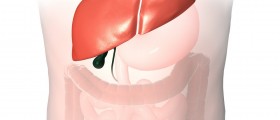
Varices are dilated veins in the esophagus that develop due to increased pressure in the portal venous system. Once these blood vessels enlarge enough and their wall becomes thin enough they easily bleed and may be responsible for the loss of large amounts of blood. The very presence of varices as well as conformation of bleeding if it exists is suitably achieved with the assistance of upper endoscopy. Treatment for bleeding varices in majority of cases includes endoscopic banding and IV octreotide. In some cases patients undergo transjugular intrahepatic portosystemic shunting.
What Causes Variceal Bleeding?
Portal hypertension is a consequence of different medical conditions and the most common one is liver cirrhosis. Prolonged increase in portal vein pressure leads to increased pressure in other veins connected to the portal vein. Esophageal veins are some of them. The condition is considered serious since enlarged veins are prone to bleeding. Apart from liver cirrhosis any other chronic condition of this organ may be associated with esophageal varices in case it affects the pressure of the portal veins.
Clinical Characteristics of Variceal Bleeding
In many cases bleeding develops suddenly, it is painless and is usually massive. Bleeding generally affects blood vessels of the distal esophagus although it may also occur from the gastric fundus. Bleeding is either acute or chronic and it may also occur in a subacute form. In case of serious loss of blood patient's stool becomes black and tarry. There may be clear traces of blood in the stool. Excessive loss of blood leads to light-headedness and paleness. Vomiting and vomiting blood are two more characteristics of bleeding from esophageal varices. And finally, apart from symptoms and signs of bleeding a person also develops symptoms and signs of the condition that has led to bleeding.
Treatment for Variceal Bleeding
Physical examination shows bloody or black stool on rectal exam, low blood pressure, rapid heart rate and characteristic symptoms and signs of chronic liver disease. In order to confirm variceal bleeding the doctor performs esophagogastroduodenoscopy. Bleeding can be also confirmed with insertion of nasogastric tube into the stomach.
The goal of the treatment is cessation of bleeding. Severe bleeding may cause massive loss of blood, shock and lethal outcome. Acute bleeding requires insertion of a small lighted tube called an endoscope. The doctor may inject certain clotting medicines directly into the varices and stop the bleeding. He/she may also place a rubber band around the bleeding veins. Additional help is obtained from drugs that cause Vasoconstriction such as octreotide and vasopressin. Balloon tamponade is another method of treating bleeding varices. A tube is inserted into the stomach and by inflating it with air it puts pressure on the bleeding spot (balloon tamponade). After acute bleeding is brought under control what follows is a long term treatment for the condition and prevention of recurrent bleeding. Patients may be prescribed with several medications such as beta blockers or they undergo transjugular intrahepatic portosystemic shunt.

















Your thoughts on this
Loading...